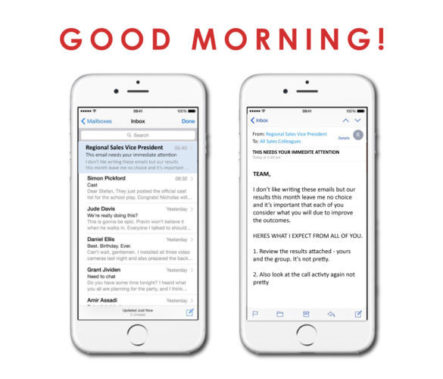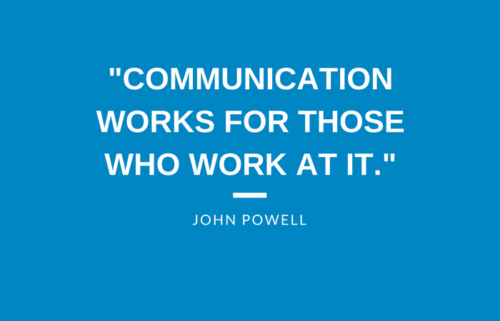Email communication is a part of the every day in business. Done well email can advance an important cause. Done poorly they have the exact opposite effect - and can send people running. Avoid these common mistakes!
Figuring out how to communicate with your employees with impact, over email isn’t easy. Nobody gets up in the morning and says “I’m going to send a crappy email to my team.” It happens. The ease of it doesn’t support quality. Critical to think about is what you are saying to your people – in word and tone.
Recently I saw first hand what it’s like to be on the receiving end of those “all staff” emails. You know the ones – things aren’t going well, and a manager sends out an email in hopes that something, anything will get better, and fast.
A view from the receiving end serves as a good lesson for how to communicate with your team
What Are They Getting From Your Emails
I was staying with friends and having breakfast with their 23-year-old son. I’ve known him since he was born so spending time with the 6’5″ version of him as a young adult and professional is equal parts refreshing and instructive.
He has an entry level B2B sales job. It’s a tough gig – real cold calling into small to mid-size businesses.
I relate to his daily grind as it resembles my first job out of college – selling copiers door to door in midtown Manhattan. These jobs are humbling and filled with valuable learnings on the realities of sales and business.
So he was telling me over coffee about an email he just received from his regional VP. It was 8 am.
The email as explained to me was dreadful. It was poorly written, short on inspiration and specific guidance. It had all the makings of an email written quickly and under duress.
If you are short on time here is a printable PDF of this article, click here.
Want To Know How To Communicate With Your Employees – Don’t Make These Mistakes
While I’m about to be quite critical of this one email, I’ve been on the other end of many poor business emails. We all have, unfortunately.
It serves as an essential reminder of what it can look like at the other end, if not done thoughtfully. Here is what I saw when I took a hard look.
1. Autocorrect typos – It was hard to follow as too many words were off from what the manager was likely trying to convey. It looked sloppy, and it loudly signaled “I didn’t read this thing before I sent it.”
Help Yourself: Read it and then reread it. Autocorrect is tricky. It solves some problems and creates others.
2. Run on sentences – It had many. Run on, and compound sentences lose people along the way particularly on mobile devices. I’m sure 95% of the recipients were using phones to read at 8 in the morning.
Help Yourself: Know the few key points clear in your head, then crisply spell out, preferably with bullets. Take a page from online marketing best practices – make it visually easy for people to scan and read.
3. Too long (& redundant) – the note covered the same ground again and again. Saying the same thing over and over and in slightly different form is many things but not persuasive. People glaze over quickly.
Help Yourself: Back to the comment above, get clear in your head about the critical message and be crisp.
4. Murky call to action – It was hard to tell what this manager wanted – other than whatever pain he was enduring to stop. Several times he referenced better performance. I guess everyone is clear on what that is and how to get there?
Help Yourself: Ask for want you want. Pick one thing, maximum of two actionable behaviors.
Or These Mistakes
5. A “why you should” solely about the larger organization – the email devoted so much real estate to financial outcomes for “the company.” Face to face it’s difficult to connect employee contributions to critical outcomes for them. In an email, it’s near impossible. Your people need to get the why – and it needs to trace to them in addition to the organization.
Help Yourself: Have the why conversation outside of urgent emails!
6. Generic to all performers – the email made no distinction between top and bottom performers. For leading performers, it’s insulting as they read and say, “I’m doing that.” For underperformers, they often lack awareness and don’t see themselves in the issues of the team or organization.
Help Yourself: Be specific and clear on what you need and from whom. Do 1:1 follows ups to get this right.
7. Oozing stress – you could feel the stress and desperation in the VP’s note. Pressure can get the best of almost any leader. However, misery isn’t a motivator.
Help Yourself: Take a deep breath. What can you realistically expect from an email? Focus on actionable behaviors. Beyond this, call them to the problem 1:1 or in a group. People will follow. Context clarifies.
Related: Maintaining a sense of calm isn’t easy. Here’s some help on topic – 5 Ways Good Leaders Model Calm In The Face Of The Everyday.
Whatever! Employee Communication Gone Awry
My friend’s son was very balanced in his reaction to the email. I probed on his opinions – both immediate and how it would impact his activities for the day. He was underwhelmed with the leadership presenting to him. I’m not sure anything changed about his day. It seems like the note was one more thing he had to rally and get past.
Whatever action or emotion it was to inspire, it did not.
I couldn’t help but wonder what the regional VP was thinking? Did he consider it a good effort? Finally, did he think that made an impact on his team and persuade them to get after it on a Friday morning?
Start With The End In Mind If You Want To Communicate With Your Employees Better
Let’s start with the fact that all colleague notes are difficult for anything other than transmitting information. As a result, changing behaviors, motivating and certainly inspiring is best-done face to face. To drive, guide behaviors and fire people up, your people need a foundation on the strategy, execution priorities and the critical contributions each of them makes.
Providing this foundation gives your future communications a robust and shared point of reference.

The need to achieve performance objectives is real. As a recovering sales leader, I relate to the stress of supreme accountability and full reliance on others to make it happen.
Telling people things suck in an email just doesn’t get it done. In fact, it will send people running.
Before you put your hands on the keyboard:
1. Ensure you have laid the groundwork for your team on priorities, expectations, and progress. Avoid treading fresh ground in these call to action type notes.
2. Whenever possible, do an “all hands” request face to face or at least by phone. Body language and tone – theirs and yours – make a huge difference. While it takes longer and logistics to pull off, it gives you a fighting chance.
For the emails you do use to communicate with your employees:
1. Short as possible. Enough said.
2. High quality work product. It should be well written. It is a sign of thoughtfulness, respect, and confidence.
3. Crystal clear on your call to action. What do you want and need from people?
Once you finish, re-read it. Reading it out loud is one of the best ways to catch missing words and autocorrect mistakes.
High-quality email communication in the current environment is a must. Give yourself the benefit of a pause on the receiving end, especially when communicating on meaty topics.
Ask yourself, what are your emails “saying” to your team? What do you want people to think, feel, do?
QUESTION: How do you make sure your emails hit the mark?
Here is a printable PDF of this article, click here.
Tools You Can Use
To support your communication efforts, DOWNLOAD my guide about communicating organizational change and the companion blog post.
DOWNLOAD The Guide: Communicate Organizational Change So It Doesn’t Kill Your People (Or You)!
GO TO The Blog Post: How To Communicate Organizational Change So It’s Way Less Painful
For a printable PDF of this post, click here.



